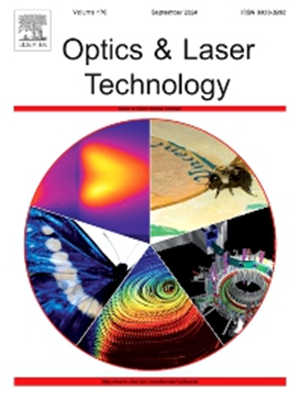Microstructure and properties behavior of in situ synthesized with high content (Ti, W) C reinforced In625 by two step-laser direct energy deposition
IF 4.6
2区 物理与天体物理
Q1 OPTICS
引用次数: 0
Abstract
The formation of sensitive interface cracks and the difficulty in processing high-concentration Ni-based ceramic coatings via direct energy deposition (LDED) present major engineering challenges. To address these, high-quality In625/ceramic coatings with various mass contents of Ti, nickel-coated graphite (Ni3C), and WC were fabricated on QT250 using two-step laser directed energy deposition (TsLDED). The influence of the Ti/C: WC molar mass ratio on the bonding interface, microstructure, phase composition, and mechanical properties of the coatings was analyzed. The results indicated that grains at the In625/ceramic coating interface formed epitaxial growth, ensuring a robust bond. In situ synthesis of (Ti, W) C, WCx (WC and W2C), M23C6, and other precipitated phases were uniformly distributed, enhancing nucleation, refining microstructure, and improving mechanical properties. The addition of Ti facilitated the transformation of WCx to (Ti, W) C. High Ti and C concentrations promoted eutectic structure formation in the matrix phase, enhancing performance. The In625 + 56 % Ti – 14 % Ni3C – 30 % WC composite coating exhibited the highest microhardness and the lowest friction coefficient, with microhardness 5.61 and 3.6 times that of QT250 and In625 coatings, respectively, and a friction coefficient 0.3 times that of In625. Variations in the Ti/C: WC molar mass ratio directly affected the content, proportion, and type of (Ti, W) C, WCx, γ-Ni, and eutectic structures comprising M23C6, NiTix, Ni2W4C, Cr2Ti, and γ-Ni, influencing microstructure evolution and mechanical properties. The TsLDED process thus enables the preparation of In625/ceramic reinforced coatings with improved mechanical properties.
采用两步激光直接能量沉积法原位合成的高含量(Ti、W)C 增强 In625 的微观结构和性能特性
敏感界面裂纹的形成以及通过直接能量沉积 (LDED) 加工高浓度镍基陶瓷涂层的困难,给工程设计带来了重大挑战。为了解决这些问题,我们采用两步激光直接能量沉积(TsLDED)技术在 QT250 上制造了具有不同质量分数的 Ti、镍涂层石墨(Ni3C)和 WC 的高质量 In625/陶瓷涂层。分析了 Ti/C:WC 摩尔质量比对涂层的结合界面、微观结构、相组成和机械性能的影响。结果表明,In625/陶瓷涂层界面上的晶粒形成了外延生长,确保了牢固的结合。原位合成的(Ti、W)C、WCx(WC 和 W2C)、M23C6 和其他析出相分布均匀,增强了成核能力,细化了微观结构,提高了机械性能。高浓度的 Ti 和 C 促进了基体相共晶结构的形成,从而提高了性能。In625 + 56 % Ti - 14 % Ni3C - 30 % WC 复合涂层显示出最高的显微硬度和最低的摩擦系数,显微硬度分别是 QT250 和 In625 涂层的 5.61 倍和 3.6 倍,摩擦系数是 In625 涂层的 0.3 倍。Ti/C: WC 摩尔质量比的变化直接影响 (Ti, W) C、WCx、γ-Ni 以及由 M23C6、NiTix、Ni2W4C、Cr2Ti 和 γ-Ni 组成的共晶结构的含量、比例和类型,从而影响微观结构的演变和机械性能。因此,TsLDED 工艺能够制备出具有更好机械性能的 In625/陶瓷增强涂层。
本文章由计算机程序翻译,如有差异,请以英文原文为准。
求助全文
约1分钟内获得全文
求助全文
来源期刊
CiteScore
8.50
自引率
10.00%
发文量
1060
审稿时长
3.4 months
期刊介绍:
Optics & Laser Technology aims to provide a vehicle for the publication of a broad range of high quality research and review papers in those fields of scientific and engineering research appertaining to the development and application of the technology of optics and lasers. Papers describing original work in these areas are submitted to rigorous refereeing prior to acceptance for publication.
The scope of Optics & Laser Technology encompasses, but is not restricted to, the following areas:
•development in all types of lasers
•developments in optoelectronic devices and photonics
•developments in new photonics and optical concepts
•developments in conventional optics, optical instruments and components
•techniques of optical metrology, including interferometry and optical fibre sensors
•LIDAR and other non-contact optical measurement techniques, including optical methods in heat and fluid flow
•applications of lasers to materials processing, optical NDT display (including holography) and optical communication
•research and development in the field of laser safety including studies of hazards resulting from the applications of lasers (laser safety, hazards of laser fume)
•developments in optical computing and optical information processing
•developments in new optical materials
•developments in new optical characterization methods and techniques
•developments in quantum optics
•developments in light assisted micro and nanofabrication methods and techniques
•developments in nanophotonics and biophotonics
•developments in imaging processing and systems

 求助内容:
求助内容: 应助结果提醒方式:
应助结果提醒方式:


